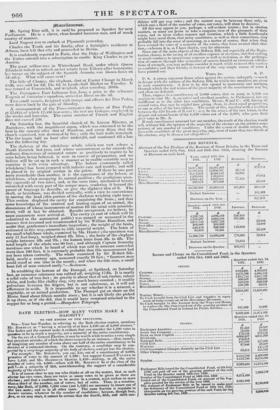Mr. Spring Rice will, it is said be proposed as
Speaker for next Parliament. He is a clever, clear-headed business man, and of much suavity of manner.
Lord Nugent was to embark at Plymouth yesterday.
Charles the Tenth and his family, after a fortnight's residence at Altona, have left that city and proceeded to Berlin.
It is confidently reported in Paris, that the Duke of Wellington and the Tories entered into a subscription to enable King Charles to go to Austria.
The great willow-tree in Whitechapel Road, under which Queen Elizabeth halted to refresh on her return from Tilbury after haranguing her troops on the subject of the Spanish Armada, was blown down on Monday. What will come next ?
The hide of Chunee, the elephant, shot at Exeter Change in March 1826, was sold for 32l. 12s. 6d. in Leadenhall Market on Tuesday. It was tanned at Greenwich, and weighed, after rounding, 2691b.
The Portuguese East Indiaman San Joao, a prize to the schooner Eugenic of Sartorius's squadron, arrived at Brest on the 3d.
Two small vessels, freighted with troops and officers for Don Pedro, were driven back by the gale of Monday.
A correspondent of the Times estimates the forces of Don Pedro at 21,00U, of which 17,500 bear arms ; the rest are Galegos, employed in the works and batteries. The entire number of French and English does not exceed 500.
On Saturday last, the beautiful church of St. Lieven Minster, at Zurickzee, with the magnificent organ, which was esteemed to be the best in the country after that of Haarlem, and every thing that the church contained, was destroyed by fire ; only the bare walls remained. The fire began half an hour after midnight, and continued till a late hour the following day.
The skeleton of the whalebone whale which was cast ashore a North Berwick last year, and whose measurement so far exceeds the ordinary dimensions of animated nature as positively to require to be seen before being believed, is now in course of preparation, and we believe will be set up in such a manner as to enable scientific men to examine it with every advantage. The, baleen (commonly called whalebone) has been prepared with infinite care and trouble, and will be placed in its original section in the palate. If there be one part more remarkable than another, it is the appearance of the baleen, or whalebone, when occupying its natural position ; the prodigious quan- tity (upwards of. two tons), and, at the same time, mechanical beauty connected with every part of the unique mass, rendering it beyond the power of language to describe, or give the slightest idea of it. The skull, or brainbone, was divided vertically, with a view to convenience in moving the head (this portion of the skeleton weighing eight tons). This section displayed the cavity for containing the brain ; and thus some knowledge of the sentient and leading organ of an animal, the dimensions of whose instruments of motion fill the mind with astonish- ment, will at last be obtained. Results unexpected, we believe, by Inost anatomists were arrived at. The cavity (a cast of which will be submitted to the anatomical public) was gauged or measured in the manner first invented and recommended by Sir William Hamilton, and under that gentleman's immediate inspection ; the weight of the brain, estimated in this way, amounts to 541b. imperial weight. The brain of the small whalebone whale, examined by Mr. Hunter (the specimen was only. 17 feet long), weighed about 41b. 10oz. ; the brain of the elephant weighs between 61b. and 71b. ; the human brain from 31b. to 41b. The total length of the whale was 80 feet ; and although Captain Scoresby mentions one which he heard of which was said to measure somewhat more than 100 feet, it is extremely probable that this measurement had not been taken correctly. The whale examined by Sir Robert Sib- bald; nearly a century ago, measured exactly 78 feet; "fourteen men could stand at one time in the mouth ; and when the tide rose, a small boat full of men entered easily."-Scotsman.
la scrubbing the bottom of the Donegal, at Spithead, on Saturday last, an immense substance was rubbed off, weighing 1731b. It is nearly a solid cube of two feet ; its gravity is about that of oak timber, colour white, and looks like chalky clay, very much honey-combed ; it readily pulverizes between the fingers, but is not calcareous, as it will not effervesce in acids. It is impossible to say whether it is a mineral, a 'vegetable, or an animal production. The Donegal got on shore on the Horse Sand about fifteen months since ; but it is not likely she picked it up there, or if she did, that it would have remained attached to the copper for so long a period.-Hampshire Telegraph.



























 Previous page
Previous page